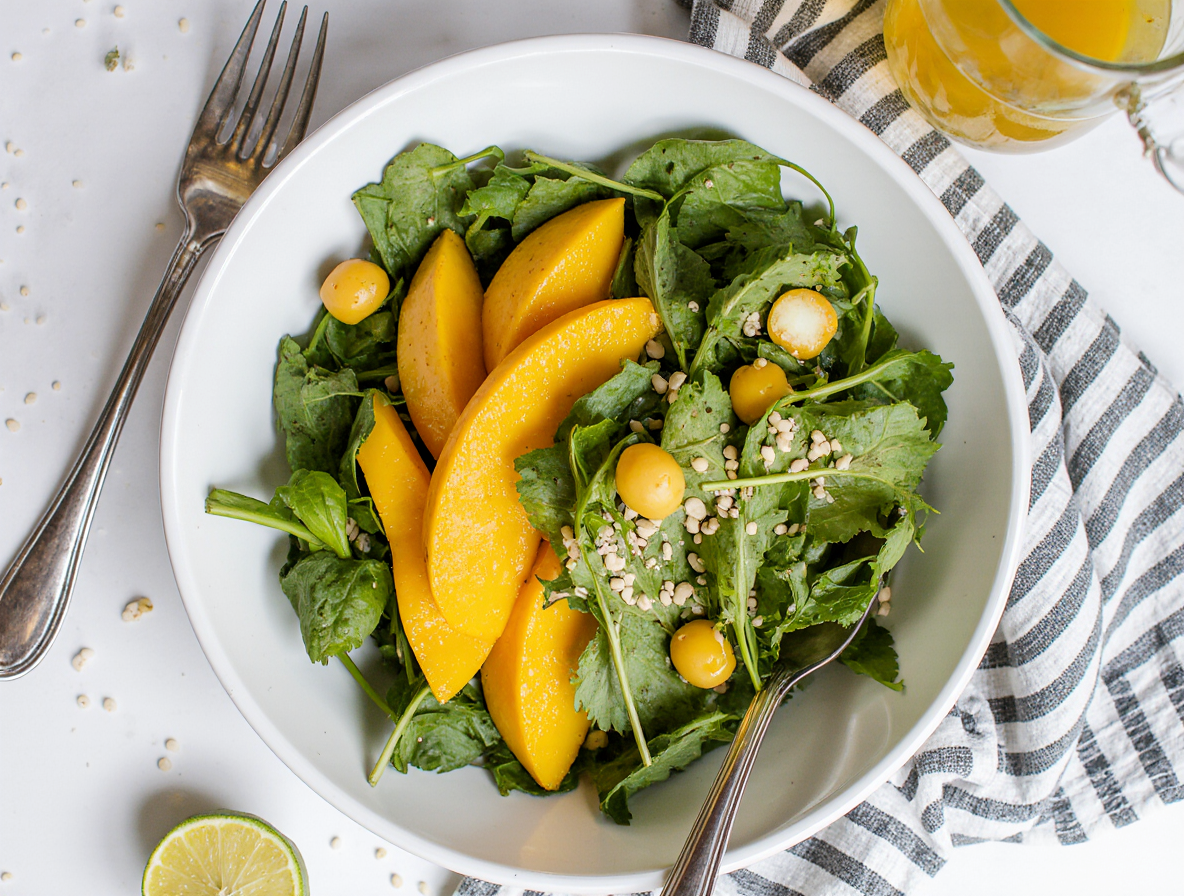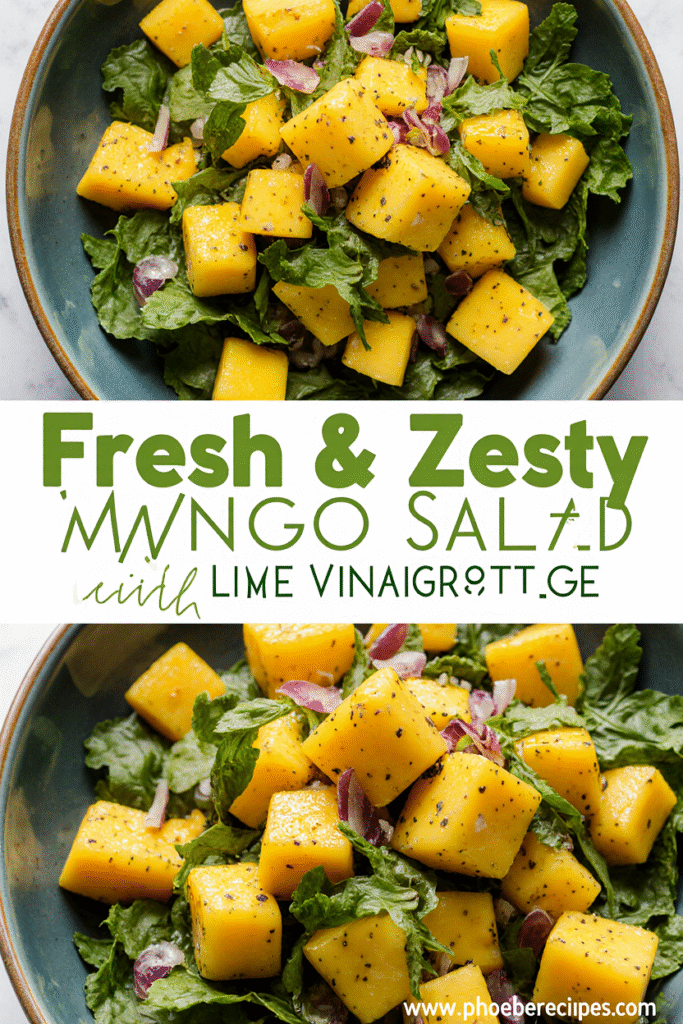The Secret to Perfect Mango Lime Dressing: A Chef’s Summer Favorite
Mango lime dressing transforms ordinary salads into vibrant summer masterpieces that never fail to draw “oohs” and “aahs” when I bring them to the table. Ready in just 15 minutes, this ultra-refreshing combination perfectly captures the essence of summer flavors while adding a splash of color to any meal.
I’ve found that this versatile mango salad dressing pairs wonderfully with grilled seafood, tacos, or grain bowls. Additionally, it works as a mango lime vinaigrette over fresh greens or as a mango lime sauce for spring rolls. The beauty of this dressing lies not only in its bright flavor but also in its practicality – it keeps well for up to 3 days in the refrigerator, making it ideal for meal prep or entertaining.
Throughout this guide, I’ll share my chef-tested secrets for creating the perfect balance of sweet, tangy, and aromatic elements that make this dressing a standout addition to your summer recipe collection. From selecting the right mangoes to optional add-ins that elevate the flavor profile, we’ll cover everything you need to know about this summer favorite.
The essential ingredients for mango lime dressing
Creating a stellar mango lime dressing begins with selecting quality ingredients that complement each other perfectly. The magic happens when sweet, tangy, and savory elements come together in perfect harmony.
Choosing the right mango variety
The foundation of any exceptional mango lime dressing is, naturally, the mango itself. For the most flavorful results, I reach for Ataulfo mangoes (sometimes called Honey or Champagne mangoes) whenever possible. These small, golden-yellow fruits deliver a creamy texture and intensely sweet flavor that shines in dressings.
Tommy Atkins mangoes, though more widely available, offer less fragrance and flavor intensity. If using this variety, you might need additional seasoning to enhance the overall taste. Kent mangoes provide another excellent option with their juicy, less fibrous flesh.
Remember that mangoes should feel heavy for their size and yield slightly to gentle pressure when ripe. Contrary to what many believe, some wrinkles on Ataulfo mangoes actually indicate perfect ripeness, not spoilage.
Why fresh lime juice matters
Fresh lime juice is non-negotiable for a vibrant mango lime dressing. Unlike bottled alternatives, freshly squeezed lime juice provides brighter flavor and more aromatic compounds. Moreover, fresh lime juice enhances the natural flavors of fruits and vegetables without adding fat or excess calories.
To extract maximum juice, I roll the lime firmly under my palm before cutting, then use a citrus reamer or juicer. For an extra dimension of flavor, consider incorporating some lime zest as well.
Balancing sweetness with honey or sugar
Most mango varieties provide natural sweetness, yet a touch of additional sweetener creates perfect balance. Raw honey adds complexity and helps emulsify the dressing, whereas maple syrup offers a richer sweetness with subtle caramel notes.
Depending on the ripeness of your mango, adjust sweetener quantities accordingly. An underripe mango might need slightly more sweetness, while perfectly ripe fruit requires less.
Fresh herbs: cilantro, mint, or basil?
Fresh herbs transform a simple mango lime dressing into something extraordinary. Cilantro adds bright, citrusy notes that complement the tropical profile perfectly. Nevertheless, mint delivers a cooling freshness that pairs wonderfully with the sweet mango.
For those who find cilantro tastes soapy (a genetic predisposition affecting some people), basil makes an excellent alternative with its aromatic, slightly peppery profile. Regardless of which herb you choose, finely chop it to distribute the flavor evenly throughout your dressing.
Optional add-ins: chili flakes, ginger, or garlic
Elevate your mango lime dressing with thoughtfully chosen add-ins. A pinch of chili flakes brings gentle heat that balances the sweetness, while freshly grated ginger adds warmth and subtle spiciness. Subsequently, a small clove of garlic provides savory depth.
For a bolder flavor profile, try adding finely minced jalapeño or serrano pepper. Indeed, even a dash of cumin can introduce an earthy dimension that pairs beautifully with the tropical ingredients.
How to make mango lime dressing step-by-step
The hands-on process of creating this mango lime dressing is straightforward once you master a few essential techniques. With the right approach, I find the preparation to be almost as enjoyable as the final result.
Peeling and cutting the mango
First, I place the mango stem-side down on a cutting board. Using a sharp chef’s knife, I slice along both sides of the flat oval pit, creating two halves and a middle section containing the pit. For the middle section, I carefully cut around the pit to salvage any remaining flesh. To peel each half, I either use a Y-shaped vegetable peeler or score the flesh in a grid pattern and scoop it out with a large spoon. If your mango is extremely ripe and slippery, pop it in the freezer for 15 minutes to firm it up slightly.
Juicing and zesting the lime
To extract maximum juice, I roll the lime firmly under my palm on the countertop. This simple action breaks down the internal membranes, making it easier to extract every drop. Once softened, I use a microplane to collect the zest before cutting and juicing. In particular, always zest before juicing – it’s nearly impossible to do afterward! Fresh lime juice is essential for this dressing; the bottled variety simply won’t deliver the same vibrant flavor.
Blending for the perfect texture
Once my ingredients are prepped, I add the mango chunks, lime juice, zest, oil, and any desired seasonings (honey, salt, pepper, garlic) to a blender or food processor. A high-speed blender creates the smoothest consistency, especially important given mango’s fibrous nature. Pulse initially, then blend continuously for 1-2 minutes until completely smooth.
Adjusting consistency with oil or water
After blending, I assess the texture. For a thinner mango lime vinaigrette, I add water one tablespoon at a time while blending. For a creamier mango lime dressing, I slowly drizzle in additional oil while the blender runs. Taste as you go – consistency adjustments often require flavor rebalancing as well.
Serving ideas and pairing suggestions
The versatility of mango lime dressing extends far beyond its delicious flavor profile. Once you’ve blended up a batch, there are countless ways to incorporate this tropical concoction into your meals.
As a mango salad dressing
This vibrant dressing transforms ordinary greens into extraordinary culinary experiences. For a refreshing summer salad, I pour it over fresh spinach topped with blackberries and pecans. Furthermore, it pairs beautifully with crispy purple cabbage, radishes, and lettuce for a colorful veggie bowl.
For protein-rich options, consider adding:
- Grilled shrimp (a match made in heaven!)
- Baked lime salmon
- Shredded rotisserie chicken
The sweet-tangy combination specifically complements fruit salads, making it perfect for enhancing seasonal berries and tropical fruits.
Drizzled over grilled seafood or chicken
Mango lime dressing creates magic when paired with proteins. The sweetness complements the smokiness of grilled mahi-mahi “bringing this fish recipe to new delicious heights”. Similarly, it adds “an unusual flavor kick to simple grilled salmon”.
For poultry lovers, this dressing elevates grilled chicken into a must-try dish. Simply prepare your chicken, grill to perfection, consequently finishing with a generous drizzle of the mango lime dressing. To enhance presentation, serve with grilled lime wedges on the side for an extra citrusy aroma.
Topping for tacos or grain bowls
The mango lime goodness serves as an excellent sauce for Mexican or southwestern-style dishes. For grain bowls, select your favorite base (quinoa, brown rice, farro), add crispy vegetables, and finish with this dressing. Occasionally, I mix it with cauliflower rice as a vibrant side for tacos.
As a dip or mango lime sauce for spring rolls
Perhaps my favorite application—using this dressing as a dipping sauce. The sweetness and tanginess make it ideal for fresh spring rolls. The sauce is “great with fish dishes,” hence perfect with coconut shrimp or fish goujons. Many enthusiasts report putting this versatile sauce “on everything” from sandwiches to burgers, even drizzling it over pizza.
For a delightful presentation, serve spring rolls sliced in half with a sprinkle of sesame seeds alongside the mango sauce.
Tips, variations, and storage
Personalizing your mango lime dressing opens up a world of flavor possibilities. With a few simple tweaks, this versatile sauce can be adapted to suit any palate or dietary need.
How to make creamy mango lime dressing
For a richer texture, transform your basic mango lime dressing by adding plain yogurt or Greek yogurt. Alternatively, blend in 1/4 cup of raw, unsalted cashews for a dairy-free creamy option. To achieve ultimate creaminess without altering the flavor profile too much, try adding avocado, which pairs beautifully with the tropical notes of the mango.
Spicy version with chili or jalapeño
Heat lovers can easily spice up this dressing by adding finely sliced jalapeño or Thai chili. For controlled heat, remove the seeds before blending. Rather than blending these spicy elements, consider chopping them finely and stirring them in at the end—this preserves the vibrant color of your dressing. Red pepper flakes offer a convenient alternative when fresh chilies aren’t available.
Vegan swaps and sugar-free options
Make this dressing vegan by substituting maple syrup for honey. For sugar-free versions, rely on the natural sweetness of perfectly ripe mangoes—no additional sweeteners needed. Hemp seeds can replace cashews for those with nut allergies.
How long it lasts in the fridge
Properly stored in an airtight container, mango lime dressing typically lasts 5-7 days in the refrigerator. Mason jars with tight-fitting lids maximize shelf life. For longer storage, freeze the dressing in zip-top bags laid flat to save space—this preserves quality for up to 3 months.
Make-ahead tips for meal prep
Firstly, prepare double batches to use throughout the week. For salad meal prep, store the dressing separately and combine just before serving. Except for avocado, most ingredients can be prepared in advance—add avocado just before serving to prevent browning. Frozen mango chunks work perfectly when fresh aren’t available, making this dressing accessible year-round.
Conclusion
This mango lime dressing stands as a testament to how simple ingredients can create extraordinary flavors. Throughout this guide, we’ve explored everything from selecting the perfect Ataulfo mangoes to balancing sweet and tangy notes with fresh lime juice and herbs. The beauty of this dressing undoubtedly lies in its versatility – whether drizzled over crisp salads, paired with grilled seafood, or used as a dipping sauce for spring rolls.
Many home cooks shy away from homemade dressings, yet this 15-minute recipe proves that exceptional flavor doesn’t require complex techniques or hard-to-find ingredients. Additionally, the ability to customize with chili, ginger, or various herbs means you can tailor it perfectly to your palate.
Certainly, the make-ahead potential makes this dressing a practical addition to your meal prep routine. The vibrant color and tropical flavors bring summer sunshine to your table any time of year, especially when using frozen mango chunks during off-seasons.
Therefore, next time you’re looking to elevate an ordinary meal, remember this mango lime dressing. The perfect balance of sweet, tangy, and aromatic elements will transform your dishes while drawing compliments from family and friends alike. After all, sometimes the simplest recipes become our most treasured kitchen secrets – and this bright, refreshing dressing might just become yours.
FAQs
Q1. How long does homemade mango lime dressing last? When stored in an airtight container in the refrigerator, homemade mango lime dressing typically lasts for 5-7 days. For longer storage, you can freeze it for up to 3 months.
Q2. What’s the best type of mango to use for mango lime dressing? Ataulfo mangoes (also known as Honey or Champagne mangoes) are ideal for mango lime dressing due to their creamy texture and intense sweet flavor. Kent mangoes are also a good option as they’re juicy and less fibrous.
Q3. Can I make this dressing vegan or sugar-free? Yes, you can easily make vegan mango lime dressing by substituting maple syrup for honey. For a sugar-free version, use perfectly ripe mangoes without additional sweeteners. Hemp seeds can replace cashews for a nut-free, vegan option.
Q4. What are some creative ways to use mango lime dressing? Mango lime dressing is versatile. You can use it as a salad dressing, drizzle it over grilled seafood or chicken, use it as a topping for tacos or grain bowls, or serve it as a dipping sauce for spring rolls.
Q5. How can I adjust the consistency of the mango lime dressing? To thin the dressing, add water one tablespoon at a time while blending. For a creamier texture, slowly drizzle in additional oil while blending. You can also add yogurt or blended cashews for a richer consistency.


